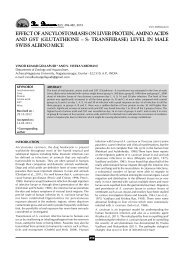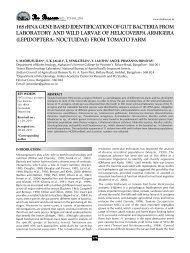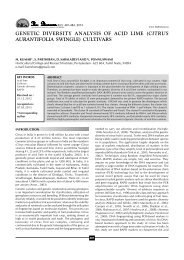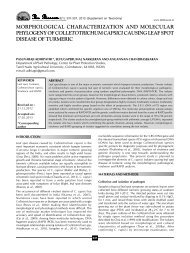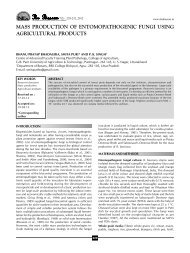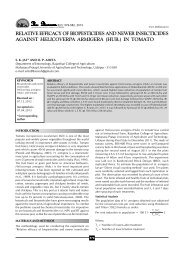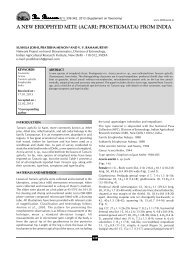earthworms in the himalaya and western ghats ... - THE BIOSCAN
earthworms in the himalaya and western ghats ... - THE BIOSCAN
earthworms in the himalaya and western ghats ... - THE BIOSCAN
You also want an ePaper? Increase the reach of your titles
YUMPU automatically turns print PDFs into web optimized ePapers that Google loves.
MADHAB C. DASH AND K. G. SAXENA<br />
Table 4: Earthworm species richness <strong>in</strong> Easternghat l<strong>and</strong> uses (Based on Mishra <strong>and</strong> Dash, 1984; Senapati et al., 2005)<br />
S.no. Species L<strong>and</strong> Uses<br />
Shift<strong>in</strong>g Cultivation<br />
Natural Disturbed 8-year old Cropp<strong>in</strong>g Eucalyptus<br />
Forest fallow phase plantation<br />
1. Drawida calebi + + - - -<br />
2. Drawida willsi + - - - -<br />
3. Eutyphoeus <strong>in</strong>commodes + - + + -<br />
4. E.waltoni - - - + -<br />
5. Eutyphoeus sps. + - - + -<br />
6. Lampito mauritii + + - - +<br />
7. Lennogaster dashi - - - - +<br />
8. Lennogaster pusillus + - + + -<br />
9. Ocnerodrilus occidentalis + + - - -<br />
10. Octochaetona surensis + + - - -<br />
11. Pellogaster bengalensis + + + + -<br />
12. Ramiella bishambari + + + - -<br />
<strong>the</strong> N<strong>and</strong>a Devi Biosphere Reserve, earthworm abundance<br />
decl<strong>in</strong>ed with decl<strong>in</strong>e <strong>in</strong> temperature (i.e., <strong>in</strong>crease <strong>in</strong> elevation)<br />
<strong>and</strong> was sensitive to both season <strong>and</strong> l<strong>and</strong> use management,<br />
with significant <strong>in</strong>teractions between species, season <strong>and</strong><br />
management practices. Flooded paddy systems had <strong>the</strong> lowest<br />
<strong>and</strong> <strong>the</strong> home gardens <strong>the</strong> highest species diversity as well as<br />
abundance (Maikhuri et al., 2005). Earthworm abundance <strong>in</strong><br />
<strong>the</strong> village l<strong>and</strong>scapes at lower elevations was higher (89-940<br />
<strong>in</strong>dividuals per m 2 ) compared to that at higher elevations (5-<br />
150 per m 2 ) (Table 2). In <strong>western</strong>/central Himalayan region<br />
<strong>and</strong> Tripura <strong>in</strong> north-eastern Himalaya, endogeic <strong>and</strong><br />
endogeic-anecic dom<strong>in</strong>ate. In rubber plantations <strong>in</strong> Tripura<br />
established after 1962, 15 species are endogeic <strong>and</strong> only five<br />
species are epi-anecic. Fur<strong>the</strong>r, rubber plantations gave way<br />
to exotics like Pontoscolex corethrurus (Chaudhuri et al., 2008;<br />
Chaudhuri <strong>and</strong> Bhattacharjee, 2009).<br />
In Nilgiri Biosphere Reserve, 14 species of <strong>earthworms</strong> were<br />
recorded, with 2-8 species occurr<strong>in</strong>g <strong>in</strong> different l<strong>and</strong> use types<br />
<strong>and</strong> total earthworm abundance <strong>in</strong> <strong>the</strong> range of 124-560 per<br />
m2 . Occurrence of endogeic Parryodrilus lavelee <strong>and</strong><br />
Pontoscolex corethrurus <strong>in</strong> almost all l<strong>and</strong> uses <strong>in</strong>clud<strong>in</strong>g<br />
degraded l<strong>and</strong>s suggests that <strong>the</strong>se species may have a<br />
potential for rapid restoration of soil fertility <strong>in</strong> degraded l<strong>and</strong>s<br />
(Ch<strong>and</strong>rashekara et al., 2008). In most studies, population<br />
size has been estimated <strong>in</strong> terms of numerical abundance <strong>and</strong><br />
not <strong>in</strong> terms of biomass.<br />
Table 3 gives ecological category, feed<strong>in</strong>g habit, <strong>and</strong> habitat<br />
<strong>and</strong> size relationship of eight species, out of 20 species of<br />
<strong>earthworms</strong> of rubber plantations raised <strong>in</strong> undulat<strong>in</strong>g areas<br />
<strong>in</strong> Tripura (Chaudhuri et al., 2008, Chaudhuri <strong>and</strong><br />
Bhattacharjee, 2009). This type of study will be useful for<br />
Himalayan <strong>and</strong> o<strong>the</strong>r regions to identify <strong>the</strong> suitable species<br />
for l<strong>and</strong> use management. Functional attributes <strong>and</strong> ecological<br />
strategies of different earthworm species need to be worked<br />
out to optimize <strong>the</strong> contributions of <strong>earthworms</strong> to ecosystem<br />
services <strong>and</strong> resilience of agroecosytems.<br />
Functional attributes: Bioturbation activity<br />
Bioturbation refers to <strong>the</strong> biological rework<strong>in</strong>g of soil <strong>and</strong><br />
sediments, <strong>and</strong> its importance was first highlighted by Charles<br />
Darw<strong>in</strong> (1881). Bioturbation is now recognized as an<br />
archetypal example of ‘ecosystem eng<strong>in</strong>eer<strong>in</strong>g’, modify<strong>in</strong>g<br />
geochemical gradients, redistribut<strong>in</strong>g food resources <strong>and</strong><br />
6<br />
microbes <strong>in</strong> soil column. Bioturbation played a key role <strong>in</strong> <strong>the</strong><br />
evolution of metazoan life at <strong>the</strong> end of <strong>the</strong> Precambrian Era<br />
(Muys et al., 2003). Earthworm casts conta<strong>in</strong> more water<br />
soluble aggregates <strong>and</strong> higher nutrient concentrations than<br />
<strong>the</strong> surround<strong>in</strong>g soils. Soils with <strong>earthworms</strong> dra<strong>in</strong> 4 to 10<br />
times faster than soils without <strong>earthworms</strong> (Guild, 1952, 1955;<br />
Low, 1955; Dash <strong>and</strong> Patra, 1979; Petersen <strong>and</strong> Luxton, 1982;<br />
Bhadauria <strong>and</strong> Ramakrishnan, 1989; Bhadauria et al., 1997).<br />
Bhadauria <strong>and</strong> Ramakrishnan (1991) estimated cast<br />
production at a rate of 20 tons, 35 tons, 40 tons per hectare<br />
per year <strong>in</strong> a 5-year-old p<strong>in</strong>e forest, a 35-year-old p<strong>in</strong>e forest,<br />
<strong>and</strong> a sacred grove (close to climax vegetation), respectively,<br />
<strong>in</strong> <strong>the</strong> north-eastern hill region of India. Chaudhuri et al. (2008)<br />
estimated cast production at a rate of 2.51 ton per ha per year<br />
<strong>in</strong> rubber plantations <strong>in</strong> Tripura <strong>in</strong> <strong>the</strong> north-eastern India.<br />
These rates of cast production are substantially lower than <strong>the</strong><br />
rates of 77-141 tons hectare per year reported <strong>in</strong> temperate/<br />
tropical ecosystems (Satchell, 1967; Dash <strong>and</strong> Patra 1979).<br />
Estimation of cast production <strong>in</strong> different l<strong>and</strong> uses would<br />
<strong>in</strong>dicate <strong>the</strong> functional role of <strong>earthworms</strong> but such studies<br />
cover<strong>in</strong>g different l<strong>and</strong>-uses <strong>and</strong> eco-regions <strong>in</strong> India are<br />
lack<strong>in</strong>g.<br />
L<strong>and</strong> use change <strong>and</strong> <strong>earthworms</strong><br />
Bhadauria <strong>and</strong> Ramakrishnan (2005) worked on earthworm<br />
community structure <strong>in</strong> relation to l<strong>and</strong> use change <strong>in</strong> shift<strong>in</strong>g<br />
agricultural l<strong>and</strong>scapes <strong>in</strong> <strong>the</strong> north-eastern Himalaya (Fig. 2),<br />
Chaudhuri et al. (2008, 2009) <strong>in</strong> rubber plantations <strong>in</strong> Tripura,<br />
Ch<strong>and</strong>rashekara et al. (2008) <strong>in</strong> Nilgiri Biosphere, Senapati et<br />
al. (1994 <strong>and</strong> 2002) <strong>in</strong> tea gardens <strong>in</strong> south Indi <strong>and</strong> Mishra<br />
<strong>and</strong> Dash (1984) (Table 4), Dash <strong>and</strong> Senapati (1991); Behera<br />
et al. (1999) <strong>and</strong> Senapati et al. (2005) <strong>in</strong> Orissa <strong>in</strong> south-east<br />
India.<br />
Based on <strong>the</strong>se studies, some generalizations can be made.<br />
Conversion of natural forests to shift<strong>in</strong>g agriculture <strong>and</strong><br />
plantations results <strong>in</strong> some loss of earthworm species richness<br />
toge<strong>the</strong>r with changes <strong>in</strong> composition of soil fauna community<br />
structure <strong>and</strong> function. Exotic <strong>and</strong> native species coexist <strong>in</strong><br />
natural <strong>and</strong> derived (managed) ecosystems but exotics are<br />
less frequent <strong>in</strong> primary forests. Endopolyhumics <strong>in</strong> primary<br />
forests <strong>and</strong> Endomesohumics <strong>in</strong> derived ecosystems (manmanaged)<br />
dom<strong>in</strong>ate <strong>the</strong> earthworm community structure <strong>in</strong><br />
north-east India. However <strong>in</strong> central Himalayas,



